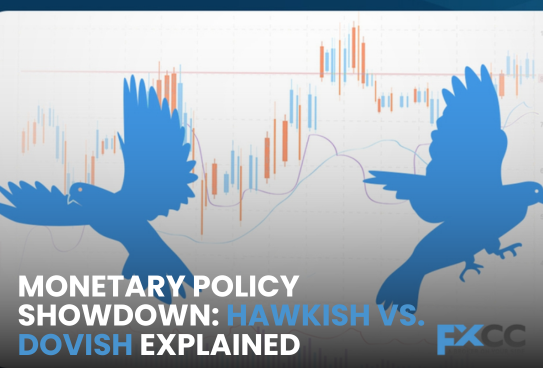Monetary policy is one of the most important tools governments use to manage their economies. Central banks, such as the Federal Reserve in the United States, are responsible for managing a nation’s monetary policy. or the European Central Bank, adjust interest rates and other financial levers to maintain stability and growth. When discussing monetary policy, two key terms often arise: hawkish and dovish. These terms describe the stances policymakers take based on their priorities, whether they’re more concerned with inflation or economic growth.

Let’s dive into what it means to be hawkish or dovish, and why these terms are so significant in shaping a nation’s economic future.
What Is a Hawkish Monetary Policy?
A hawkish stance is all about controlling inflation. Policymakers who adopt this approach view rising prices (inflation) as the biggest threat to economic health. Inflation, a sustained increase in the general price level of goods and services, diminishes the purchasing power of currency, making it more costly to acquire goods and services over time. Hawks believe that if inflation gets out of control, it can destabilize the entire economy, so they prioritize keeping it in check.
To counteract inflation, hawkish policy makers advocate for higher interest rates. By increasing borrowing costs, these policymakers aim to curtail economic activity and reduce demand for goods and services, ultimately mitigating inflationary pressures. When businesses and consumers borrow less, they also tend to spend less. As a result, demand for goods and services decreases, which helps cool off rising prices. This strategy is aimed at keeping inflation in a manageable range, often around 2% annually in many developed economies.
One key characteristic of a hawkish approach is the belief that preventing inflation is more important than short-term economic growth. Hawks often accept slower economic growth or even higher unemployment rates as trade-offs for keeping inflation under control. They argue that failing to address inflation early on can lead to much larger problems later, such as hyperinflation or financial crises.
What Is a Dovish Monetary Policy?
In contrast, a dovish approach focuses more on promoting economic growth and reducing unemployment. Doves worry less about inflation, particularly when it’s low, and more about making sure the economy is growing steadily. They tend to prioritize the short-term benefits of low interest rates, which can stimulate borrowing, investment, and consumer spending.
Dovish policy makers advocate for lower interest rates. When interest rates are low, it’s cheaper for businesses to take out loans to expand, hire more employees, or invest in new technologies. Consumers are also more likely to borrow for big purchases, like homes or cars, when interest rates are low. All of this helps boost economic activity.
Doves generally believe that a bit of inflation is acceptable, especially if it means creating jobs and driving growth. They argue that as long as inflation remains within a certain range, the central bank should focus on fostering a healthy labor market and strong economic performance. If inflation does become a concern, doves usually prefer to deal with it after economic growth has been secured.
Key Differences Between Hawkish and Dovish Policies
Inflation vs. Growth: Hawks prioritize controlling inflation, even if it means slowing down the economy. Doves focus on economic growth and employment, accepting a higher risk of inflation.
Interest Rates: Hawks advocate for raising interest rates to cool off inflation, while doves prefer lower rates to encourage borrowing and spending.
Economic Outlook: Hawks tend to worry about the long-term effects of inflation on the economy, while doves are more concerned with addressing short-term issues like unemployment and recession.
The Real-World Application of Hawkish and Dovish Policies
In the real world, central banks don’t stick strictly to one approach. Instead, they often adjust their stance based on the state of the economy. For example, during the global financial crisis in 2008, central banks around the world adopted extremely dovish policies to stimulate growth. Interest rates were slashed to near zero, and massive amounts of money were injected into the economy through programs like quantitative easing.
More recently, in response to rising inflation rates in 2021 and 2022, many central banks have taken a more hawkish stance. The U.S. Federal Reserve, for example, began aggressively raising interest rates in an effort to bring inflation back down to its target range.

The Balancing Act
One of the biggest challenges for central banks is striking a balance between these two approaches. If interest rates are kept too low for too long, the economy may overheat, leading to unsustainable growth and inflation. On the other hand, raising rates too quickly can stifle economic activity, causing businesses to halt expansion plans and consumers to cut back on spending.
Central bankers must constantly assess economic conditions to determine when it’s time to be hawkish and when a dovish approach is more appropriate. It’s not an easy task, as external factors like global trade, political instability, and even natural disasters can throw off carefully laid plans.
Conclusion In summary, hawkish and dovish monetary policies represent two opposing approaches to managing the economy. A hawkish stance focuses on controlling inflation through higher interest rates, while a dovish stance prioritizes growth and employment, often with lower rates. The key is balance, as both inflation and stagnation can harm the economy if left unchecked. Understanding these terms can help you grasp how central banks make decisions that affect everything from the cost of your mortgage to the price of groceries.


